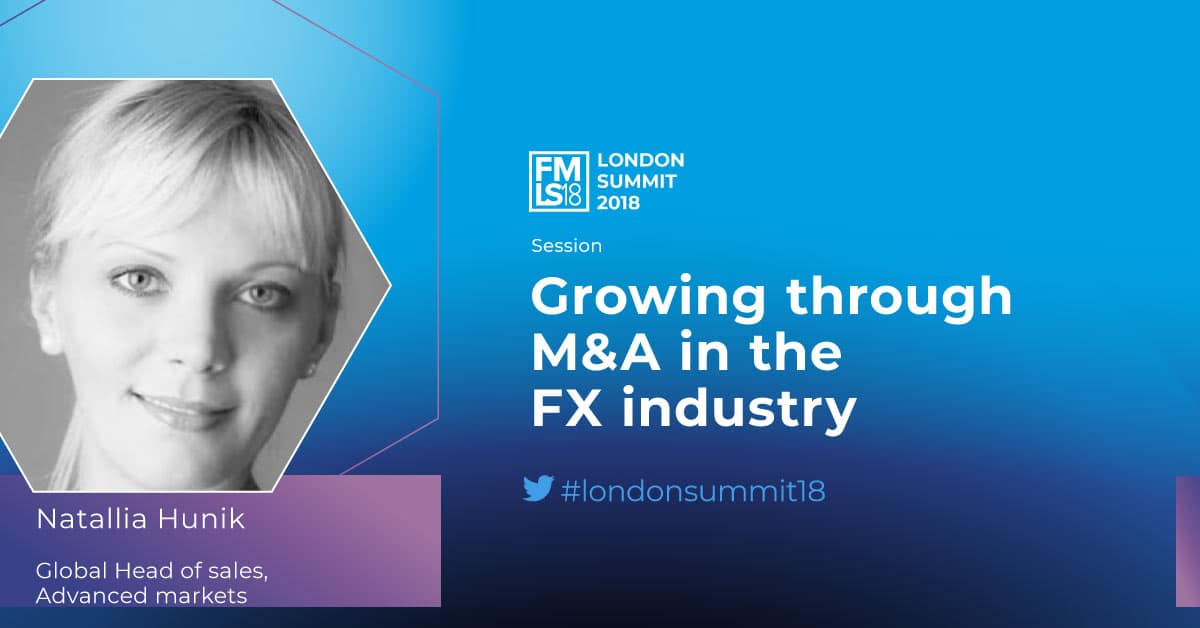As London Summit 2018 draws near, Finance Magnates sat down with some of the event’s speakers to get a sense of what’s coming. In this piece, we focus on valuing FX companies and the intricacies of the M&A process.
With the recent round of regulatory changes across Europe in 2018, many industry experts are already predicting another wave of industry consolidations. This, in turn, leads to a series of questions for companies, ranging from valuation to charting successful industry exits.
While there is no one-size-fits-all approach to this process, there are certainly ways to make your company more attractive to potential sellers. Natallia Hunik lays out the current playing field and the secrets that brokers need to be aware of.
What is your position and what does your role entail?
I head FAM Clearing LLC - JV venture between Advanced Markets and Fortex. Day to day, I focus on creating and leading high performing FX sales teams and helping organizations operating in capital markets space optimize their Liquidity sourcing, their technology needs, and their operational efficiency.
I’m also responsible for spearheading firms’ global expansion efforts by cultivating business relationships with industry leaders around the globe.
What is the single most important market event or development in 2018 so far?
By far, I think 2018 is the year of Regulation . MiFID 2 and ESMA were looming over brokers’ heads for a while, but 2018 became the year of these becoming a reality. Firms of all sizes had to adjust their business processes in order to comply with new rules.
While we are yet to find out how this impacts the business long term, in the short term there are several key developments:
- Clients already reap the rewards of increased transparency, although it is not clear retail investors understand how to analyze and consume the data they see
- Increased M&A activity in the space as owners looking to exit ahead of anticipated downturn in trading volumes and increased capital requirements
- In a panic, European financial firms are looking to buy licenses/companies outside of Eurozone and exploiting loopholes with re-classifying their clients to the professional investors
- With growth projections in Europe stalling, FX businesses are on the mission to find markets with high growth potential like MENA, Latin America & Africa
What are the biggest challenges that the FX trading community is facing? How do they affect your field?
Given the changes undergoing in the sector, the biggest challenges that industry is facing is regulatory compliance and sustaining growth and profitability.
Where should brokers look at when seeking areas for growth?
Brokers are looking for growth in emerging markets as there is higher profitability you can yield in this market. However, there is a higher customer turnover and lower retention. Developed markets, on the other hand, are being abandoned by smaller and medium-sized firms as they think they lack resources and expertise to service those sophisticated clients.
Larger firms, on the other hand, look at those markets as a land of opportunity, with IG expanding to the United States, for example.
Changes in regulation could stir further consolidation in the retail FX space, but brokers often find it difficult to find buyers. What should they do to make their shop attractive for an M&A?
Generally, compared to software industry where we are looking at the multiples of x21-25 EBIDTA on average, for example, if you look at M&A transactions in FX broker space, the best exits are at x5 EBIDTA that we have witnessed so far.
Why is there such a dichotomy?
There are many reasons. Like product business vs. service business, the enormous risk associated with running brokerage business that mainly resides with the market risk, lack of intellectual property and many others.
For that reason, traditional Venture Capital and Private Equity firms do not have a great appetite for such investments given high risk and low return multiples. Therefore, FX firms should be working towards working with a strategic buyer, which would typically be larger FX brokerage conglomerates or players from industry’s vertical.
So how to make your brokerage more attractive to the potential buyer?
- Invest in intellectual property (even if it’s a mobile map, custom built CRM, etc.)
- Mitigate your market risk exposure by deploying “risk-free” models (like STP) for at least a portion of your business
- Diversify. Retail business is lucrative due to its high margin. However, there are downsides as well as enhanced regulatory scrutiny that comes with it. FX brokers should try to build an institutional arm with more sustainable volumes and better retention.
- Mitigate counterparty risk by working with licensed and reputable counterparties that are able to deliver superior value, robust system, and consistent execution.
- Invest in financial licenses in reputable jurisdictions.
Natallia Hunik will be speaking at the upcoming London Summit 2018 about growing operations and opportunities via M&A activity in the FX industry. Learn more and register here today!

















